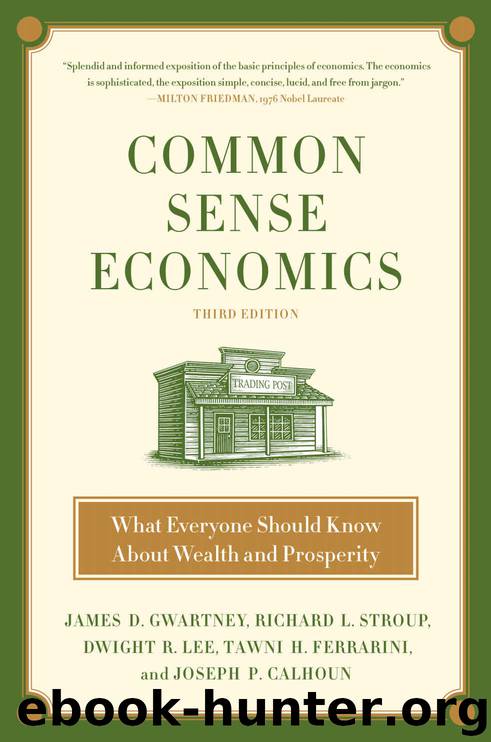Common Sense Economics: What Everyone Should Know About Wealth and Prosperity by James D. Gwartney & Richard L. Stroup & Dwight R. Lee & Tawni Hunt Ferrarini

Author:James D. Gwartney & Richard L. Stroup & Dwight R. Lee & Tawni Hunt Ferrarini [Gwartney, James D.]
Language: eng
Format: epub
ISBN: 9781250106957
Publisher: St. Martin's Press
Published: 2016-06-14T05:00:00+00:00
Source: U.S. Dept. of Commerce, Characteristics of the Population Below the Poverty Level: 1982, Table 5; and U.S. Census Bureau, Historical Poverty Tables—Families, www.census.gov/hhes/www/poverty/histpov/hstpov4.xls.
No doubt, the proponents of the War on Poverty programs were motivated by lofty objectives. However, as we have stressed, good intentions do not guarantee the desired outcome. As Exhibit 12 shows, the poverty rate was declining rapidly prior to the War on Poverty. The share of families in poverty declined from 32 percent in 1947 to 13.9 percent in 1965. The downward trend continued for a few more years, reaching 10 percent in 1968. In the late 1960s, only a few years after the War on Poverty transfers were initiated, the declining trend in the poverty rate came to a halt. Since 1970, the poverty rate of families has fluctuated within a relatively narrow range between 10 percent and 12 percent. In 2013, the poverty rate was 11.2 percent, virtually the same as the figure when the War on Poverty programs were initiated.17 Given that income per person, adjusted for inflation, has more than doubled since the late 1960s, this lack of progress is startling.
Why haven’t the anti-poverty transfer programs been more effective? The transfers generate three unintended secondary effects that slow progress against poverty.
First, the income-linked transfers reduce the incentive of low-income individuals to earn, move up the income ladder, and escape poverty. There are at least seventy-five means-tested government programs (for example, food stamps, Medicaid, housing subsidies, school lunches, and child healthcare insurance) that target the poor for assistance. Individuals are eligible to receive benefits under these programs as long as their income is at or below a designated income level. The benefits from most of these programs are scaled down and eventually eliminated as the recipients’ earnings rise.
As a result, many low-income recipients get caught in a poverty trap. If they earn more, their transfer benefits are reduced and the combination of the additional taxes owed and transfers lost means that they get to keep only 10, 20, or 30 percent of the additional earnings. In some cases, the additional earnings may even reduce the recipient’s net income. Thus, the poverty trap substantially reduces the incentive for many low-income recipients to work, earn more, acquire experience, and move up the job ladder. Hence, to a large degree, the transfers merely replace income that would have otherwise been earned, and as a result, the net gains of the poor are small—far less than the transfer spending suggests.
Second, transfer programs that significantly reduce the hardship of poverty also reduce the opportunity cost of risky choices such as dropping out of school or the workforce, childbearing by teenagers and unmarried women, divorce, abandonment of children by fathers, and drug use that often lead to poverty. As more people choose these high-risk options, it is very difficult to reduce the poverty rate. The poverty rate of single-parent households is approximately five times the rate for two-parent households. Today, nearly 30 percent of children live in single-parent families, up from 12 percent in 1968.
Download
This site does not store any files on its server. We only index and link to content provided by other sites. Please contact the content providers to delete copyright contents if any and email us, we'll remove relevant links or contents immediately.
The Secret History by Donna Tartt(18849)
The Social Justice Warrior Handbook by Lisa De Pasquale(12142)
Thirteen Reasons Why by Jay Asher(8796)
This Is How You Lose Her by Junot Diaz(6795)
Weapons of Math Destruction by Cathy O'Neil(6146)
Zero to One by Peter Thiel(5686)
Beartown by Fredrik Backman(5599)
The Myth of the Strong Leader by Archie Brown(5425)
The Fire Next Time by James Baldwin(5249)
How Democracies Die by Steven Levitsky & Daniel Ziblatt(5128)
Promise Me, Dad by Joe Biden(5087)
Stone's Rules by Roger Stone(5026)
A Higher Loyalty: Truth, Lies, and Leadership by James Comey(4845)
100 Deadly Skills by Clint Emerson(4840)
Rise and Kill First by Ronen Bergman(4704)
Secrecy World by Jake Bernstein(4646)
The David Icke Guide to the Global Conspiracy (and how to end it) by David Icke(4626)
The Farm by Tom Rob Smith(4438)
The Doomsday Machine by Daniel Ellsberg(4416)
